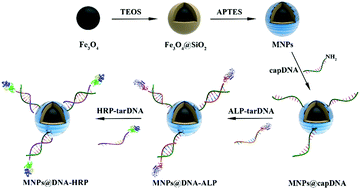Efficient immobilization of enzymes onto magnetic nanoparticles by DNA strand displacement: a stable and high-performance biocatalyst†
Abstract
Enzymes usually have poor thermal and operational stability as well as limited reuse cycles, which greatly limit their practical applications. This study reports a novel strategy for enzyme immobilization based on toehold-mediated DNA strand displacement on modified magnetic nanoparticles using alkaline phosphatase (ALP) and horseradish peroxidase (HRP) as different model enzymes. The immobilized enzyme procedure by DNA strand displacement exhibited high reversibility and reproducibility, and the mild, convenient approach achieved successive enzyme immobilization through triggering a toehold-mediated DNA strand displacement reaction. The immobilized HRP exhibited promising thermal stability after 50 min incubation at 50 °C and 60 °C, which were about 6.5- and 9.7-fold greater than the free enzyme, respectively. Notably, the immobilized enzyme exhibited excellent long-term storage stability, and the enzymatic activities were about 34.4- and 24.9-fold greater than free HRP after storage at 4 °C for 68 days and at room temperature for 9 days, respectively. The immobilized enzyme also preserved high performance towards long-term incubation stability, compared to the free enzyme, and excellent reusability, which showed a high degree of activity (more than 73%) after 5 cycles. Thus, the developed strategy exhibited a promising alternative platform with high magnetic responsiveness and significantly enhanced properties for the immobilization of important enzymes and their broad applications.



 Please wait while we load your content...
Please wait while we load your content...